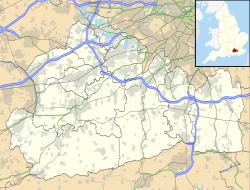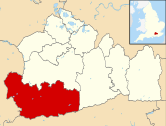
An arboretum is a botanical collection composed exclusively of trees and shrubs of a variety of species. Originally mostly created as a section in a larger garden or park for specimens of mostly non-local species, many modern arboreta are in botanical gardens as living collections of woody plants and are intended at least in part for scientific study.

The United States National Arboretum is an arboretum in northeast Washington, D.C., operated by the United States Department of Agriculture's Agricultural Research Service. It was established in 1927 by an act of Congress after a campaign by USDA Chief Botanist Frederick Vernon Coville.

The Arnold Arboretum is a botanical research institution and free public park affiliated with Harvard University and located in the Jamaica Plain and Roslindale neighborhoods of Boston.

Ulmus laevisPall., variously known as the European white elm, fluttering elm, spreading elm, stately elm and, in the United States, the Russian elm, is a large deciduous tree native to Europe, from France northeast to southern Finland, east beyond the Urals into Kyrgyzstan and Kazakhstan, and southeast to Bulgaria and the Crimea; there are also disjunct populations in the Caucasus and Spain, the latter now considered a relict population rather than an introduction by man, and possibly the origin of the European population. U. laevis is rare in the UK, although its random distribution, together with the absence of any record of its introduction, has led at least one British authority to consider it native. NB: The epithet 'white' elm commonly used by British foresters alluded to the timber of the wych elm.
Wilfrid Fox was a dermatologist in the United Kingdom. He practised at St George's Hospital, London.

The Arboretum is a city park in Nottingham, England.

Ulmus davidiana var. japonica, the Japanese elm, is one of the larger and more graceful Asiatic elms, endemic to much of continental northeast Asia and Japan, where it grows in swamp forest on young alluvial soils, although much of this habitat has now been lost to intensive rice cultivation.
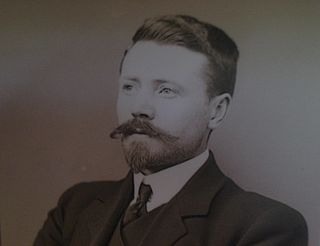
Ernest Henry "Chinese" Wilson, better known as E. H. Wilson, was a British plant collector and explorer who introduced a large range of about 2,000 Asian plant species to the West; some sixty bear his name.

The Siberian elm cultivar Ulmus pumila 'Hansen' is a little-known American tree of obscure origin, possibly raised from seed collected by the horticulturist and botanist Prof. Niels Hansen during his expedition to Siberia in 1897.
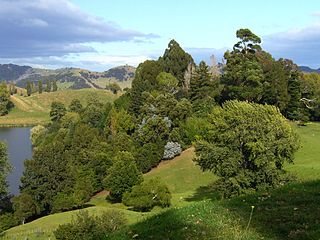
Hackfalls Arboretum is an arboretum in New Zealand. It was founded in the 1950s by Bob Berry. It is part of Hackfalls Station, a sheep and cattle farm of about 10 square kilometres, owned by the Berry family. The farm is in Tiniroto, a tiny village in the eastern part of the North Island, between Gisborne (town) and Wairoa.
The arboretum covers 0.56 km2, along the borders of two lakes, and has about 3,500 species of trees and shrubs. It includes many different oaks "spaced in rolling pastureland, allowing each to develop fully, and limbed up to enable grass to grow underneath". The most important part of the collection is about 50 different taxa of Mexican oaks.
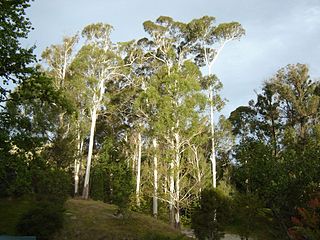
Eastwoodhill is the national arboretum of New Zealand. It covers 131 hectares (1.31 km2) and is located 35 km northwest of Gisborne, in the hill country of Ngatapa. It was founded in 1910 by William Douglas Cook. Cook's life work would become the creation of a giant collection of Northern Hemisphere temperate climate zone trees in New Zealand – a dream that would eventually cost him all his money – buying and importing thousands of trees from New Zealand and British nurseries.

The Rural Life Living Museum is in Tilford, Surrey near Farnham in southern England. Formerly known as the Old Kiln Agricultural Museum and the Rural Life Centre, it is an open-air museum of country life run by the Old Kiln Museum Trust, a charitable trust. It covers over 10 acres (40,000 m2) of field, woodland and barns, and collects and preserves objects associated with farming and goods used by local craftsmen between 1750 and 1960. There is also an arboretum with over one hundred species of trees.

Swettenham is a village and civil parish in the unitary authority of Cheshire East and the ceremonial county of Cheshire, England. According to the 2001 Official UK Census, the population of the entire civil parish was 248, increasing to 291 at the 2011 Census. The civil parish includes the hamlet of Kermincham.

Windlesham Arboretum is between the villages of Windlesham and Lightwater in Surrey, United Kingdom, just south of Junction 3 on the M3. The arboretum features lakes, monuments, follies, a small chapel and approximately 22,000 mature and rare trees. The Windle Brook runs through the arboretum and has seven main footbridges and approximately ten ponds on each side, some of which are more properly identifiable as lakes based on size. The land and lakes, including a scattered number of buildings altogether consist of just over 1 square kilometre (0.39 sq mi).

The Grange Farm Arboretum is a small private arboretum comprising 3 hectares accommodating over 800 trees, mostly native and ornamental species or cultivars, notably oaks, ashes, walnuts and elms, growing on a calcareous loam.

The Ulmus pumila cultivar 'Aurescens' was introduced by Georg Dieck at the National Arboretum, Zöschen, Germany, circa 1885. Dieck grew the tree from seed collected in the Ili valley, Turkestan by the lawyer and amateur naturalist Vladislav E. Niedzwiecki while in exile there. Dieck originally named the tree U. pinnato-ramosaf.aurescens.

The field elm cultivar Ulmus minor 'Viminalis' (:'willow-like'), occasionally referred to as the twiggy field elm, was raised by Masters in 1817, and listed in 1831 as U. campestris viminalis, without description. Loudon added a general description in 1838, and the Cambridge University Herbarium acquired a leaf specimen of the tree in 1866. Moss, writing in 1912, said that the Ulmus campestris viminalis from Cambridge University Herbarium was the only elm he thought agreed with the original Plot's elm as illustrated by Dr. Plot in 1677 from specimens growing in an avenue and coppice at Hanwell near Banbury. Elwes and Henry (1913) also considered Loudon's Ulmus campestris viminalis to be Dr Plot's elm. Its 19th-century name, U. campestris var. viminalis, led the cultivar to be classified for a time as a variety of English Elm. On the Continent, 'Viminalis' was the Ulmus antarcticaHort., 'zierliche Ulme' [:'dainty elm'] of Kirchner's Arboretum Muscaviense (1864).


